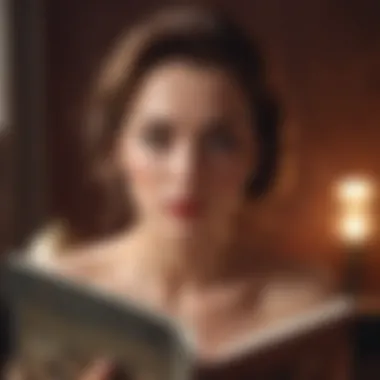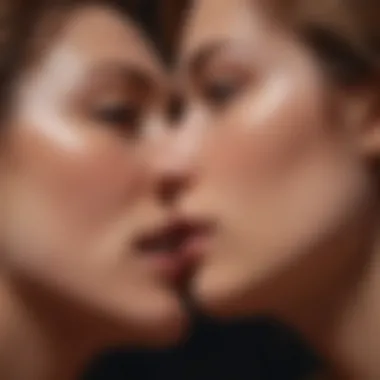Exploring Erotic Literature: History, Themes, Impact


Intro
Erotic literature has often occupied a unique space within the spectrum of literary art. It extends beyond simple depictions of physical relationships, serving as a mirror to societal constructs and evolving perceptions of intimacy, desire, and sexuality. Understanding this complex genre necessitates an examination of its historical roots and thematic paradigms.
Across various cultures and epochs, erotic literature has remained both revered and reviled. From the ancient texts of Sappho and the poetic verses of the Arabian Nights to more contemporary works by authors such as Anaïs Nin and E.L. James, the genre has demonstrated a remarkable ability to adapt to the changing tides of cultural norms and expectations. This dynamic landscape prompts an exploration into the pivotal works and influential writers who have defined and redefined the boundaries of erotic narratives.
This article aims to provide a comprehensive review of erotic literature, touching on critical themes and cultural implications. By analyzing reader reception and the current discourse surrounding desire and intimacy, this piece seeks to position erotic novels as significant components of literary studies, worthy of deep academic inquiry and thoughtful discussion.
Preamble to Erotic Literature
Erotic literature occupies a unique space within the broader realm of literary expression. It invites readers to confront themes of desire, intimacy, and often societal taboos. This topic is of paramount importance in our exploration, as it provides insight into human emotions and relationships. By examining erotic literature, we unlock a door to understanding how individuals navigate their sexuality and reflect on cultural norms.
In this section, we will delve into three key areas: the definition of erotic literature, its historical context, and its evolution over time. Collectively, these components will clarify its significance and how it serves as a mirror to societal attitudes towards sex and love.
Defining Erotic Literature
Erotic literature can be seen as a genre that emphasizes sexual themes and human relationships. It differs fundamentally from pornography, as it often integrates character development, emotional depth, and narrative complexity. The central motifs often revolve around love, sexual desire, and the intricacies of human connection. The work's intentions are generally to entice and provoke thought rather than merely to thrill.
The exact definition can vary among scholars and readers alike, which adds to its complexity. However, it is generally agreed that erotic literature aims to explore sensuality not just as an act but as part of the larger human experience. Therefore, understanding this definition is crucial for our narrative, as it sets the groundwork for discussions regarding thematic elements and cultural implications.
Historical Context and Evolution
The roots of erotic literature reach back to ancient civilizations, with texts such as "The Kama Sutra" of India and "The Decameron" by Giovanni Boccaccio. Each of these works reflects the cultural values and attitudes of their time, becoming indispensable for understanding the evolution of erotic themes across different epochs.
As society transformed through the centuries, so did the portrayal of eroticism in literature. The Enlightenment era, marked by a growing interest in individuality and explorations of pleasure, saw significant contributions from authors such as the Marquis de Sade and Anaïs Nin. Their writings questioned established norms and expanded the boundaries of sexual expression.
In the modern context, the advent of digital platforms has democratized access to erotic literature, allowing for more diverse voices and narratives. Discussions surrounding themes of consent, empowerment, and identity continue to emerge within contemporary works, showing how the genre adapts to current societal dynamics. Understanding this historical progression allows us to appreciate the depth and richness of erotic literature today.
Thematic Elements in Erotic Novels
The thematic elements in erotic novels are essential in understanding the depth and richness of this genre. They provide insight into the emotions, motivations, and cultural narratives surrounding human desire and sexuality. Such elements not only enrich the storyline but also reflect societal views of intimacy and eroticism. Recognizing these themes allows readers to engage with the material on multiple levels, fostering a deeper appreciation for the complexities involved in erotic literature.
Exploration of Desire
Desire is a central theme in erotic literature. It drives the plot and character development, creating tension and anticipation. This theme often unfolds through a series of encounters or experiences that showcase the characters’ longing for one another. Readers witness the evolution of desire from initial attraction to intense physical connection.
The depiction of desire can vary dramatically across different works. Some novels may emphasize raw passion, while others delve into the emotional and psychological facets of longing. This variance often depends on the author's intent and cultural context. For instance, in Delta of Venus by Anaïs Nin, desire is articulated through richly detailed narratives that blend sensuality with depth of character. This allows readers to resonate with both the physical and emotional dimensions of desire.
Portrayal of Intimacy
Intimacy is another significant aspect in erotic novels, as it explores the connections that characters share beyond physical attraction. It is often portrayed as a deeply personal experience that enhances the sexual encounters, bridging the gap between physical and emotional bonds.
In many instances, intimacy emphasizes vulnerability and trust. For example, in The Sexual Practices of Quodoushka by Amara Charles, the focus lies on the interplay of communication and emotional safety among partners. This approach invites readers to consider intimacy as a holistic experience, weaving together physical pleasure and emotional safety.
"Intimacy can turn a transient encounter into a lasting connection, showcasing the transformative power of sexual experiences."
Cultural Attitudes Towards Sex
Cultural attitudes towards sexuality are critical in shaping the narratives found in erotic literature. These attitudes may fluctuate based on societal norms, historical contexts, and individual perspectives toward sex. As such, understanding these cultural dynamics enriches the reading experience.


For example, in literature from more conservative societies, erotic themes may be subdued or veiled. In contrast, modern works often embrace more explicit depictions of sexuality. Noteworthy contributions, such as Fifty Shades of Grey by E.L. James, demonstrate how contemporary culture is increasingly open to discussing sexual desires, preferences, and boundaries.
This cultural interplay informs not only the content of the erotic literature but also its reception by audiences. It raises critical discussions about feminism, power dynamics, and consent, urging readers to reflect on how these themes relate to their own lives.
In summary, the thematic elements of desire, intimacy, and cultural attitudes towards sex form a rich tapestry in erotic literature. This complexity enhances readers' understanding, providing a multifaceted lens through which to explore the genre. Recognizing these thematic components allows for a deeper discourse on the significance of erotic narratives in capturing human experience.
Notable Authors and Their Contributions
The topic of notable authors in erotic literature is crucial in understanding the evolution and depth of this genre. Authors have shaped the art of erotic storytelling, each contributing unique perspectives and styles. Their works not only push boundaries but also mirror societal norms and individual desires. Delving into their contributions helps illuminate the complexities of erotic narratives, showcasing how these texts influence and reflect changing cultural landscapes.
Historical Figures in Erotic Literature
The roots of erotic literature trace back through centuries, marked by influential figures whose works have lasting significance. Authors like Marquis de Sade and Anaïs Nin stand as pillars in this tradition.
- Marquis de Sade: His provocative works, such as "Justine" and "The 120 Days of Sodom," challenged contemporary moral standards. Sade’s explicit exploration of themes like power dynamics and sexual freedom forced readers to confront their own values surrounding morality and desire.
- Anaïs Nin: Known for her diaries and short stories, Nin provided confidence to female sexuality in her landmark collection "Delta of Venus." Her fluid prose and intimate exploration of emotion allowed readers to engage with the complexity of erotic themes from a feminine perspective.
The contributions of these historical figures reverberate through to modern times, inspiring current writers to explore the depths of human sexuality in varied ways. Their works not only set the stage for the genre but also stimulate ongoing discussions about boundaries in literature and society.
Contemporary Authors and Trends
In recent years, a new wave of authors has reshaped erotic literature, reflecting contemporary attitudes toward sexuality, gender, and relationships. Noteworthy authors have emerged, each navigating the genre's shifting landscape uniquely.
- E.L. James: Her "Fifty Shades" trilogy brought erotic fiction into mainstream consciousness. By blending romance with explicit sexual content, James made the genre accessible to wider audiences. This has resulted in a surge in interest in erotic narratives across different demographics.
- Leila Slimani: In her novel "Lullaby," Slimani takes a darker and psychological approach to eroticism. The novel examines desire in the context of domestic life, blending elements of suspense and social commentary.
Trends also reveal shifts in writing styles and the preferences of readers. The rise of self-publishing platforms allows authors to explore taboo topics previously considered unacceptable. This liberation encourages diverse voices and stories that resonate with varied audiences.
"The evolution of erotic literature reflects a broader cultural discourse about sex, identity, and personhood."
Analysis of Influential Works
Understanding the influential works in erotic literature is essential to grasp the broader narrative in the genre. These texts often serve as cultural touchstones, reflecting not only individual desires but also collective societal attitudes toward sexuality. They provide valuable insights into how eroticism has been articulated and perceived throughout history. Each influential work can illuminate the shifts in norms and expectations surrounding intimacy and desire, enhancing one's appreciation for the genre as a whole.
Classics of Erotic Literature
The classics of erotic literature have shaped the genre and influenced countless authors. Works like The Story of O by Pauline Réage, Lady Chatterley’s Lover by D.H. Lawrence, and The Kama Sutra are often regarded as seminal texts. Their bold explorations of sexual freedom, taboo, and the human experience fundamentally transformed the literary landscape.
The Story of O, for instance, dives deep into themes of submission and autonomy, challenging the conventional perceptions of love and desire. This novel continues to provoke discussion on the nature of consent and power dynamics in erotic relationships, making it vital in contemporary discourse.
Lady Chatterley’s Lover, on the other hand, critiques class and gender roles while offering a passionate love story. The novel's exploration of physical and emotional intimacy resonates with many readers, emphasizing the connection between sexuality and social context.
Then there is The Kama Sutra, which, beyond being a manual of sexual practices, offers a philosophical perspective on love and relationships. Its holistic approach to intimacy extends beyond the physical, positioning the text as a relevant guide even in modern discussions about eroticism.
"The classics invite us to reflect on our personal values and those imposed by society, creating a dialogue that is timeless."
Modern Spins on Classic Themes
As society continues to evolve, so does erotic literature. Modern authors take inspiration from classic themes, often reinterpreting them to address contemporary issues. One prime example is Fifty Shades of Grey by E.L. James, which revives elements found in classic works but presents them through a modern lens of consent and negotiation.
Many modern narratives incorporate diverse voices, focusing on varied experiences of sexuality and desire. Books like The Kiss Quotient by Helen Hoang introduce neurodiverse characters, exploring themes of love and intimacy in ways that were previously unseen in mainstream erotic literature.


Moreover, works such as An Ember in the Ashes by Sabaa Tahir blend sensuality with fantasy, appealing to a broader audience by merging genres. Such innovative storytelling illustrates that the realm of erotic literature is not stagnant; it evolves to reflect current societal values and the rich tapestry of human experience.
In summary, from classics that push boundaries to modern interpretations that challenge norms, the analysis of influential works offers a deeper understanding of erotic literature's role and significance in both historical and contemporary contexts.
The Role of Reader Engagement
Reader engagement is a central concept in the discourse surrounding erotic literature. It encompasses how readers connect with and interpret erotic texts, which in turn influences their perceptions of sexuality, desire, and intimacy. The element of engagement is vital, as it allows individuals to discover their own interpretations and emotional responses to the narratives presented. This not only enriches the reading experience but also provides insights into cultural attitudes toward eroticism.
One could argue that each reader brings a unique perspective shaped by their personal experiences, cultural background, and societal norms. This leads to varied interpretations of themes and characters within erotic novels. Thus, understanding reader engagement helps in evaluating erotic literature as a significant art form rather than mere entertainment.
Reader Reception and Critique
The reception of erotic literature has always been a nuanced affair. Historical and cultural contexts greatly shape how these texts are viewed. Readers' critiques often reflect entrenched social values and challenges associated with sexuality. For instance, earlier works like Fanny Hill by John Cleland faced significant backlash, mainly due to the conservative moral landscape of the period. Yet, its reception evolved, illustrating how shifting societal norms can alter perceptions over time.
Today, readers engage with erotic literature in numerous ways. Online platforms enable interactive discussions, allowing readers to share their critiques openly. This exchange fosters a community where diverse viewpoints emerge. Positive reception can lead to the normalization of erotic themes, pushing boundaries in literature. Meanwhile, negative critiques often serve as a signal for society's ongoing struggles with sexual expression and freedom.
"The evolution of reader engagement with erotic literature has shifted from silent acceptance to active discourse, challenging traditional views."
Impact of Digital Platforms
In the contemporary landscape, digital platforms have transformed how erotic literature is consumed and discussed. The rise of e-readers, blogs, and online forums has made erotic literature more accessible than ever. This shift has also democratized the publication process, allowing authors to reach audiences without the traditional constraints of print publishing.
Social media platforms like Facebook and Reddit create vibrant spaces for discussion and critique, where readers can connect over shared interests. This networking fosters communities that encourage exploration of new authors and themes within the genre. Moreover, the anonymity afforded by digital platforms allows readers to engage with content that might be stigmatized in traditional settings
As a result, there's a growing market for self-published erotic novels, which cater to diverse subgenres and tastes. The interaction fosters deeper engagement and collective understanding of perspectives on desire and relationships. It effectively redefines the boundaries of what can be expressed and appreciated in erotic literature today.
Censorship and Controversies
Censorship of erotic literature has played a significant role in shaping how these works are perceived and consumed throughout history. The struggles against censorship not only highlight the cultural attitudes towards sexuality but also raise important questions about artistic expression and freedom. Over time, many authors have faced legal issues, bans, or public scrutiny for their work because of explicit content. This often leads to broader discussions about the boundaries of art and the rights of both creators and audiences in expressing and experiencing sexuality in written form.
Historical Instances of Censorship
Throughout history, many notable works of erotic literature have faced censorship. One prominent example is the case of "Lady Chatterley's Lover" by D.H. Lawrence. Upon its release, the novel faced obscenity trials that questioned its explicit depictions of sexuality. Ultimately, this case set important legal precedents around artistic freedom in literature.
Another significant instance is the banning of "Tropic of Cancer" by Henry Miller. When first published, it was deemed obscene in the United States, leading to years of court battles before it was finally allowed. Such cases not only reveal societal discomfort with open sexual expression but also point to the evolving standards of what constitutes acceptable literature.
Current Debates on Artistic Freedom
In contemporary society, debates surrounding artistic freedom and censorship continue to be relevant, especially in the realm of erotic literature. Many argue that censorship infringes on the artist's rights to express their creativity fully. There is also an emerging conversation about digital platforms, where content moderation policies can lead to the removal or restriction of erotic literature.
The rise of self-publishing and online platforms has offered new avenues for erotic writers, yet it has also led to increased scrutiny. Discussions about what constitutes explicit content versus artistic expression are ongoing, with many advocating for broader interpretations of freedom concerning the written word.
"The suppression of erotic literature reflects society's ongoing struggle to reconcile open discussions of sexuality with traditional moral frameworks."
In summary, censorship in erotic literature serves as a critical focal point for examining both historical and modern attitudes toward sexuality. The dialogues surrounding these topics underscore the crucial relationship between literature, society, and individual liberties.
Cultural Significance of Erotic Narratives
Erotic literature serves not just as entertainment but also as a reflective surface for societal norms and beliefs about sexuality. It is crucial to understand how these narratives encapsulate and influence the cultural landscape. Erotic narratives often challenge prevailing attitudes towards sex, intimacy, and desire, prompting discussions that transcend mere titillation. This genre has evolved over centuries, adapting to the complexities of human relationships and societal expectations. By analyzing erotic literature, one can appreciate its broader cultural implications and its role in shaping discourse around sexuality.


Reflections of Societal Norms
Erotic narratives offer a unique vantage point from which to examine societal norms. These stories frequently highlight the tension between conventional morality and personal desire. Through characters and plots, they reveal how various cultures approach sexual expression and intimacy. For example, in many cultures, erotic literature reflects gender roles and power dynamics, exposing the inherent inequalities that exist.
As individuals engage with these stories, they encounter perspectives that might challenge their own views. This engagement often leads to a reevaluation of existing norms. In societies where sexuality is often repressed, erotic literature can serve as a catalyst for dialogue. It opens up a safer space for exploring desires, fantasies, and taboos, making it an essential part of cultural discourse.
Role in Feminism and Gender Studies
Erotic literature holds a significant position within feminist theory and gender studies. It invites analysis of how gender and sexuality intersect, particularly in the portrayal of female desire. Many feminist authors utilize erotic themes to subvert traditional narratives, advocating for a more inclusive understanding of sexuality.
Furthermore, these writings often challenge the male gaze. By centering female pleasure and narrating experiences from women's perspectives, authors dismantle the patriarchal constructs long embedded in literature. This re-orientation reveals the complexity of female sexuality and the multifaceted nature of consent and agency.
The exploration of erotic literature through a feminist lens contributes to ongoing discussions about sexual liberation and autonomy. It reveals that female narratives are as varied and rich as their male counterparts, urging readers to acknowledge and appreciate this diversity.
Erotic Literature in Contemporary Society
Erotic literature holds a significant place in contemporary society. This relevance emerges not only from its literary aspects but also from its ability to engage discussions around human sexuality, relationships, and societal norms. Today, these narratives offer reflections on shifting attitudes toward sex and intimacy, capturing an evolving cultural landscape.
Changing Realities and Expectations
The notion of what constitutes erotic literature is in a constant state of flux. With the advent of digital media, expectations from erotic texts have transformed drastically. Readers seek narratives that delve into emotional depth alongside physical connections. This shift prompts authors to craft stories that reflect real-life complexities of desire and intimacy.
Modern readers expect more than mere escapism; they desire authenticity and character development. This pursuit leads to a richer narrative, where characters are multifaceted, navigating their own relationships and sexualities in relatable ways. The emergence of diverse voices in erotic literature is notable. Authors from various backgrounds contribute to stories that resonate with broader audiences. This progress has enabled greater representation of minority experiences, enhancing the depth of the genre.
Integration in Popular Culture
Erotic literature's integration into popular culture is palpable. Works like E.L. James's Fifty Shades of Grey have demonstrated how mainstream acceptance can propel a genre into the public consciousness. Such texts are not simply seen as taboo but are increasingly recognized as important cultural artifacts.
The impact of these narratives extends to other media forms, such as film and television. The adaptation of erotic novels into movies often sparks conversations about desire and sexual dynamics in society. Recent titles continue to challenge existing norms, allowing audiences to engage with and reflect on their own views of sexuality.
This integration into popular culture often leads to broader discussions about consent, communication, and sexuality education, making erotic literature a crucial part of contemporary discourse. The ongoing conversations around these texts underline their importance beyond mere entertainment, reinforcing their role in shaping societal views on sexuality.
Erotic literature serves as a lens through which we can examine and discuss the complexities of human desire, identity, and relationships.
In summary, erotic literature in contemporary society not only entertains but provokes thought and reflection. As cultural attitudes evolve, so too does the narrative of erotic literature, marking its importance in literary and social discussions today.
Finale
The exploration of erotic literature reveals complex layers of meaning and societal reflection. The conclusion serves as a critical chapter, synthesizing the insights garnered throughout the article. Addressing the future of erotic literature is essential, considering its evolving role in society and how it mirrors changing norms around desire and intimacy.
Understanding the future of erotic literature necessitates looking at current trends and attitudes. As society advances, so does the perception of sexuality. The importance of inclusive narratives is increasingly recognized. Today’s audiences seek narratives that resonate with diverse experiences, transcending traditional portrayals.
The Future of Erotic Literature
The future of erotic literature seems promising but also challenging. The genre is poised to expand beyond clichés, gaining depth in storyline and character development. Writers will likely explore new themes, such as consent, mental health, and the intersection of technology with personal relationships.
Increased accessibility to digital platforms impacts how erotic stories are consumed and created.
- Digital Publishing: Self-publishing and e-books democratize the genre. Authors can share their work without traditional gatekeeping.
- Diverse Representation: Future works may increasingly reflect varied sexualities and identities, encouraging empathy and understanding.
"Erotic literature is not merely an expression of desire; it’s a reflection of the complexities of human experience."
As narratives become more inclusive, they will likely spark dialogue around vital topics like feminist perspectives and non-binary identities. Enhanced reader engagement through social media and online forums can shape discussions surrounding erotic content.
In summary, the conclusion of this comprehensive review underscores the significance of erotic literature in contemporary society. It affirms its potential to evolve and challenge societal norms while providing insight into human intimacy and desire.















